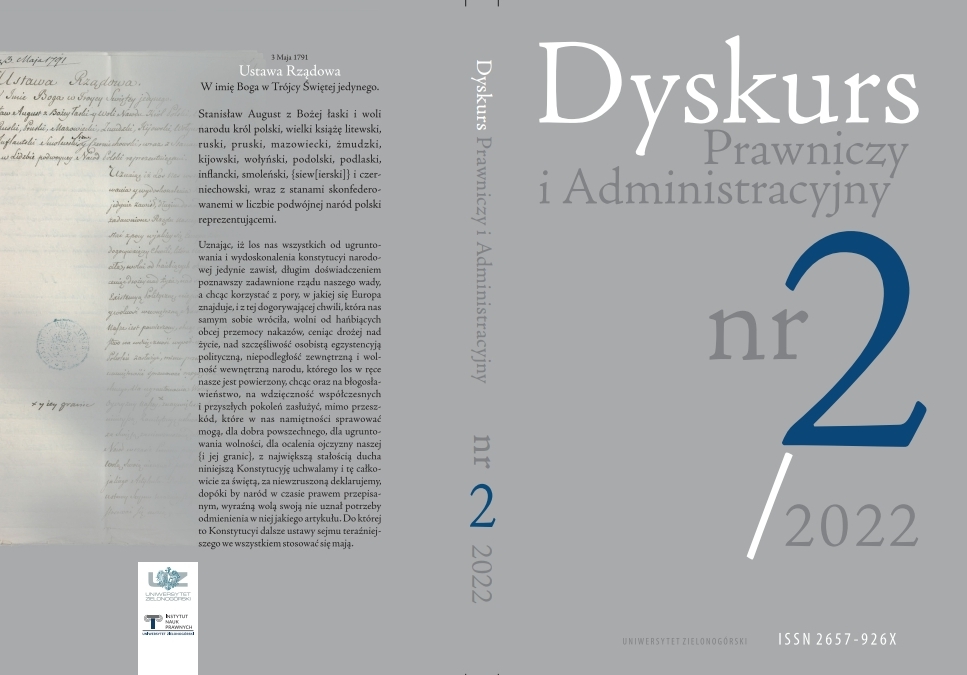Did the modern state emerge in the 16th century? Holy Roman Empire and the case of Silesia
Keywords:
Silesia, modern state, political system, Silesian administration, Holy Roman EmpireAbstract
In the construction of modern states, a particularly important role was played by the combination
of supreme, central government, with the dominance of the power of society in the regions.
The emergence of the modern state poses many difficulties for legal historians, especially concerning
time, but also space. In the area of the Holy Roman Empire, the multiplicity of states and their
internal differentiation strengthened the construction of this type of state, an example of which is
Silesia, as well as Bavaria, Hesse, or Bohemia. The paper focuses mainly on the administrative factor,
but also on the underlying social factor. The construction of a modern administration, sometimes
absolutist, encountering local resistance, is one of the most important factors in the emergence of
modern states, not only in the 15th century, as the article puts it, but also from the 13th century onwards,
as Anglo-Saxon historians would rather boldly have it.
References
Aubin H., Geschichte Schlesiens, vol. 1, Breslau 1938, p. 295.
Bahlcke J., Regionalismus und Staatsintegration im Widerstreit. Die Länder der böhmischen Krone im ersten Jahrhundert der Habsburgerherrschaft (1526-1619), Munich 1994.
Balzer O., Historia ustroju Austrii, Lwów 1899.
Barth W., Die Familie von Schönaich und die Reformation, Beuthen 1891.
Blaschke J., Geschichte der Stadt Glogau und des Glogauer Landes, Glogau 1913.
Croon G., Die landständische Verfassung von Schweidnitz-Jauer, [in:] Codex Diplomaticus Silesiae, vol. 27.
Croon G., Die landständische Verfassung von Schweidnitz-Jauer, [in:] Codex Diplomaticus Silesiae, vol. 27, Breslau 1912.
Dubreuil B., Human Evolution and the Origins of Hierarchies. The State of Nature, Cambridge 2010.
Grünhagen C., Geschichte Schlesiens, vol. 2, Gotha 1884.
Grünhagen C., Schlesien unter der Herrschaft König Ferdinands 1527-1564, “Zeitschrift des Vereins für Geschichte und Altertum Schlesiens” 1885, no. 19, pp. 77-98.
Grünhagen C., Schlesien unter Rudolf II und der Majestätsbrief 1574-1609, Gotha 1896.
Gryphius A., Glogauisches Fürstentumbs Landes Privilegia aus dem Originalen an tag gegeben, Lissa 1653.
Gude H.L., Staat von Schlesien, Frankfurt-Leipzig 1708.
Henelius N., Silesiographia renovata, necessariis scholiis, observationibus et indice aucta, Wratislaviae-Lipsiae 1704.
Historia Śląska, ed. by K. Maleczyński, vol. 1, part 3, Wrocław 1963.
Jurek P., Czas obrad ogólnośląskich zgromadzeń stanowych w XVII w., “Sobótka” 1976, vol. 31, pp. 546-560.
Krebs J., Zur Geschichte der inneren Verhältnisse Schlesiens von der Schlacht am weißen Berge bis zum Einmarsche Waldsteins, “ZVGAS” 1882, vol. 16, 1882, part 35; F. Zimmermann, op. cit., p. 15.
Kurtze Fragen und Antworten Vom Herzogthum Schlesien, Vermöge Welcher die geographische, historische und politische Merckwürdigkeiten von Schlesien, Breßlau und Leipzig 1733.
Lehns- und Besitzurkunden Schlesiens und seiner einzelnen Fürstenthümer im Mittelalter, eds. C. Grünhagen, H. Markgraf, vol. 1, Leipzig 1881.
Luchs H., Schlesische Landes- und Städtewappen, Breslau 1881.
Menzel K.A., Geschichte Schlesiens, vol. 2, Breslau 1808-1810.
Minsberg F., Geschichte der Stadt und Festung Gross-Glogau, vol. 2, Glogau 1853.
Orzechowski K., Akta do dziejów śląskiego sejmu (wiek XV-XVIII), “Sobótka” 1971, vol. 26, pp. 453-480.
Orzechowski K., Geneza i istota śląskiego conventus publicus, “Sobótka” 1972, vol. 27, pp. 561-577.
Orzechowski K., Historia ustroju Śląska (1201-1740), Wrocław 2005.
Orzechowski K., Komisje śląskiego konwentu, “Sobótka” 1974, vol. 29, pp. 35-54.
Orzechowski K., Konwent-sejm-trybunał. Ze studiów nad zgromadzeniami stanowymi feudalnego Śląska, “Sobótka” 1973, vol. 28, pp. 261-275.
Orzechowski K., Kurie śląskiego sejmu w XVII i w pierwszej połowie XVIII wieku, “Sobótka” 1978, vol.33, pp. 313-331.
Orzechowski K., O śląskich sejmach 1527 r., “Czasopismo Prawno-Historyczne” 1999, vol. 51, iss. 1-2, pp. 205-218.
Orzechowski K., Ogólnośląskie zgromadzenia stanowe, Warszawa-Wrocław 1979.
Orzechowski K., Podatek szacunkowy na tle systemu daninowego dawnego Śląska 1527-1740, Wrocław 1999.
Orzechowski K., Podejmowanie uchwał przez ogólnośląskie zgromadzenia stanowe pod rządami Habsburgów, “Sobótka” 1975, vol. 30, no. 2, pp. 127-140.
Orzechowski K., Porządek obrad śląskiego konwentu, “Sobótka” 1974, vol. 29, no. 3, pp. 307-324.
Orzechowski K., Sejm i sejmiki w ustroju feudalnego Śląska, “Sobótka” 1976, vol. 31, pp. 197-207.
Orzechowski K., Porządek obrad śląskiego konwentu, “Sobótka” 1974, vol. 29, no. 3, pp. 307-324.
Orzechowski K., Rachunki śląskich stanów (1527-1741), Wrocław 1994.
Orzechowski K., Urząd zwierzchni i konwent. Z badań nad organizacją śląskiego conventus publicus, “Sobótka” 1973, vol. 28, pp. 345-359.
Orzechowski K., Z praktyki śląskiego sejmowania w połowie XVI w., “Sobótka” 1990, vol. 45, pp. 13-37.
Österreichische Staatsarchiv, Haus- Hof- und Staatsarchiv, Staatenabteilungen: Ost- und Südeuropa AB VIII/7/4, Schlesien Ad. I/2, Krt. 4, Faz. 8: Kurzer Vermerk sowohl der ehemäligen Kayserlichen als nunmehrigen Königlichen Preußisch Schlesischen Landesverfassung (Krt. 4, pp. 50-109).
Pachaly F.W., Sammlung verschiedner Schriften über Schlesiens Geschichte und Verfassung, vol. 1, Breßlau 1790.
Palm H., Schlesiens Landesdefension im XV., XVI. und XVII. Jh., “Abhandlungen der Schlesischen Geselschaft für vaterländische Kultur” 1868, vol. 2, pp. 67-98.
Ptak M., Zgromadzenia i urzędy stanowe księstwa głogowskiego od początku XIV w. do 1742 r., Wrocław 1991.
Rachfahl F., Die Organisation der Gesamtstaatsverwaltung Schlesiens vor dem dreissigjährigen Kriege, Leipzig 1894.
Schickfuss J., New Verrmehrte schlesische Chronika und Landes Beschreibung, Jena-Breslau 1625.
Simon H., Die Ständische Verfassung von Schlesien, Breslau 1846.
Sinapius J.C., Schlesien in merkantilischer, geographischer und statistischer Hinsicht, Sorau-Leipzig 1803.
Spruyt H., The Origins, Development, and Possible Decline of the Modern State, “Annual Review of Political Science” 2002, vol. 5 (1), pp. 127-149.
Śreniowski K., Historia ustroju Śląska, Katowice-Wrocław 1948.
Tilly Ch., Coercion, Capital and European States, AD 990-1992, Blackwell 1992.
Weber M., Die schlesischen Polizei- und Landesordnungen der Frühen Neuzeit, Köln-Wiemar-Wien 1996.
Wolf J.R., Steuerpolitik im Schlesischen Ständestaat. Untersuchungen zur Sozial- und Wirtschaftsstruktur Schlesiens im 17. und 18. Jh., Heidelberg 1978.
Wutke H., Die Entwicklung der öffentlichen Verhältnisse Schlesiens vornähmlich unter den Habsburgen, vol. 1-2, Leipzig 1842-1843.
Wutke H., Die schlesischen Stände, ihr Wesen, ihr Wirken und ihr Werth in alter und neuer Zeit, Leipzig 1847.
Zimmermann F., Über die Steuerverfassung in Schlesien ein Versuch, vol. 1, Breslau 1799.
Published
How to Cite
Issue
Section
Copyright (c) 2023 Jarosław Kuczer

This work is licensed under a Creative Commons Attribution-NonCommercial-NoDerivatives 4.0 International License.



